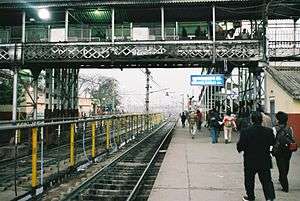Mughalsarai
| Mughalsarai मुग़लसराय مغل سرائے Deendayal Nagar | |
|---|---|
| City | |
 | |
 Mughalsarai Location in Uttar Pradesh, India | |
| Coordinates: 25°18′N 83°07′E / 25.3°N 83.12°ECoordinates: 25°18′N 83°07′E / 25.3°N 83.12°E | |
| Country |
|
| State | Uttar Pradesh |
| District | Chandauli |
| Elevation | 65 m (213 ft) |
| Population (2011) | |
| • Total | 154,692 |
| Languages | |
| • Official | Hindi, Urdu |
| Time zone | IST (UTC+5:30) |
| PIN | 232101 |
| Telephone code | 5412 |
Mughalsarai is a city and a municipal board in the Chandauli district of Uttar Pradesh. Located around 16 kilometres (10 mi) from Varanasi, it is an important railway junction in Uttar Pradesh.[1]
Location
Mughalsarai is bisected by GT Road in three parts. The northern part mainly consists of railway colonies like (Vasant Vihar), New Central Colony, Diesel Colony, Haper Colony, Loco Colony and Roza Colony, Plant-Depot Colony. It starts after the Parao Road in Varanasi and continue till Aliganj Road which comes after Railway Colony on the south.
It has also few Mohallas near to the railway station like Qassab mohal, dharamshala, mainatali and galla mandi etc. Lal Bahadur Shastri, India's second Prime Minister was born in Mughalsarai.
Railways
The Mughalsarai Railway Station is the fourth busiest station in India, with about 125 passenger trains passing through the Mughalsarai Junction. Two important railway lines intersect at the junction: Main Line (Delhi–Kanpur–Allahabad–Patna–Howrah) and Detour Line (Ambala Cantt-Saharanpur–Moradabad–Bareilly–Lucknow–Varanasi––Howrah). Mughalsarai has biggest railway yard in Asia.
References
| Wikimedia Commons has media related to Mughalsarai. |
- ↑ The National Geographical Journal of India, Volume 10. National Geographical Society of India. 1964. p. 136.
Its importance as a railway junction can well be understood by the fact that more than 50 passenger trains and over 150 goods trains pass through it within 24 hours. The amount of coal passing through Mughalsarai was about 39,000 tons daily in 1960 and the wagons carrying coal from this end to other stations numbered 1,729 per day.